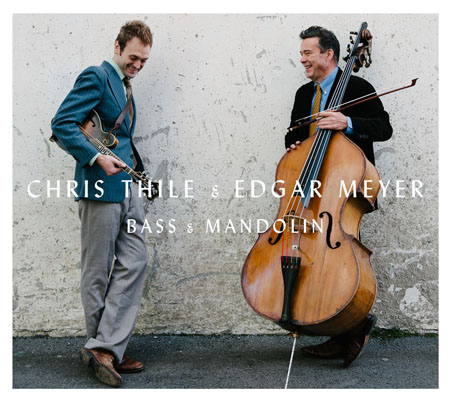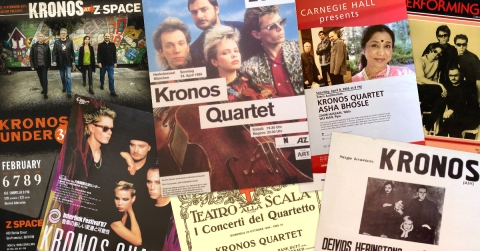Bass & Mandolin, due out September 9 on Nonesuch Records, is the second duo recording from double bassist Edgar Meyer and mandolinist Chris Thile. In this article, these two virtuosic musicians talk with writer Michael Hill about the new album and how the personal and musical relationship between them has continued to mature and deepen in the five years since the pair released its self-titled Nonesuch debut.
Bass & Mandolin, due out September 9, 2014, on Nonesuch Records, is the second duo recording from double bassist Edgar Meyer and mandolinist Chris Thile. Five years have passed since the pair released its self-titled Nonesuch debut, but in the intervening years the personal and musical relationship between these two virtuosic musicians has continued to mature and deepen, and they have often found themselves on stage or in the studio together in various configurations. In 2011, Meyer and Thile, along with violinist Stuart Duncan, joined cellist Yo-Yo Ma to create The Goat Rodeo Sessions, an album of original material that garnered the ad hoc group a Best Folk Album Grammy Award.
Though 20 years apart in age, Meyer and Thile share a seemingly effortless rapport, along with similar résumés: They are both players of extraordinary accomplishment and wide-ranging talent, as comfortable in the symphony hall as at an outdoor bluegrass festival. They are each multiple Grammy Award winners and individual recipients of the prestigious MacArthur “genius” grant. Meyer produced Thile’s mandolin album of Bach’s Sonatas and Partitas for solo violin—a challenging set, recorded over a wintry week at the same barn-turned-studio in the Berkshires where The Goat Rodeo Sessions was made—that was met with much critical acclaim. London’s Independent praised this radical reimagining of Bach, with Thile in front of the mic and Meyer behind the board, as one that “liberates the pieces from their conservatoire corsets.” Most recently, Meyer guest-starred on A Dotted Line, the long-awaited reunion album from Nickel Creek, the trio that first brought Thile into the spotlight when he was a child.
The process of creating the largely instrumental pieces that comprise The Goat Rodeo Sessions and its subsequent embrace by both critics and a large record-buying public influenced Meyer’s and Thile’s own approach to their latest duo work when they re-entered the studio together, this time at Skywalker Sound in Marin County. There is intensity and eloquence to their playing throughout these new sessions, but they didn’t shy away from the lyricism that marked the popular Yo-Yo Ma–helmed project. On their first duo album, Meyer recalls, they would push their melodies to the point of abstraction. This time, he says, “we are letting some of the melodies show.”
As Thile reflects, “We have grown a lot as a collaborative entity between our duo first recording and now, at least partially due to our work together on The Goat Rodeo Sessions. As collaborators, we’ve found a warmer voice to share. Having had the experience of writing that music and getting it to a fair amount of people, I think we went into this project wanting to write material that was balanced—that would take care of our minds and our fingers certainly, but also take care of our bodies and souls—within, of course, the rather extreme limitation of the mandolin and the bass.” But,” he adds, “Edgar plays piano, I play a little guitar, so we threw those instruments in as sort of palate cleansers.”
The ten pieces on Bass & Mandolin were co-written by Thile and Meyer, save for “Friday,” a solo composition from Meyer. The duo self-produced the disc—with ample help from their longtime associate, engineer Dave Sinko—eschewing any technical wizardry to keep the music squarely in the moment, focusing on the brilliant musical repartee between these players. The majority of these tracks represent live-in-the-studio takes of these compositions.
As Meyer notes, “For most of the songs we tried to cover ourselves with extra takes of different sections, but the reality is that we were not using much of that. Usually the stuff from the original takes was better.” Meyer masterfully demonstrates the expressiveness and versatility of the double-bass—constructing lovely violin-like melodic lines at certain points, serving as a deeper-toned, one-man rhythm section at others. The agile Thile often nimbly darts around the melodies, egging on Meyer (or vice versa), especially on tracks like “Tarnation” and “Friday.” The dialogue between mandolin and bass is lively, good-humored, fast-paced—and, yes, there are moments when a listener may find him or herself out of breath trying to keep up—but Meyer and Thile leave plenty of room for more contemplative stretches. There is a kind of gentle pastoral quality to several of these tracks, especially on tunes like “Look What I Found” and “El Cinco Real,” where piano and guitar subtly sweeten the arrangements.
“I'm happy to be part of the mix,” Meyer declares. “It affords me a lot of options. Chris is comfortable with all kinds of improvising, with lots of different musical feelings and rhythmic feelings. He has a great groove, but he can free up and play classical things with a little less rigidity. Working with Chris, I can do anything I want. I can be the string section or the rhythm section, and Chris can hold it together. I can just be a bass player or I can play the melody. Chris figured out at a very young age how to make the other person feel comfortable, musically and otherwise, and how to create a situation where they can do their best. There are not many people with whom I have so much common ground. We can get to the bottom of things very quickly.”
Before the teenage Thile had even met Meyer, he was strategizing on how to work with him: “One of the most important records of my entire life is and will always be Edgar’s Uncommon Ritual with [banjoist] Béla Fleck and [mandolinist] Mike Marshall,” Thile says, referring to an acclaimed 1997 string-trio disc that was the follow-up to Meyer’s classical-crossover hit, Appalachia Waltz. “I can remember learning all the songs from Uncommon Ritual in my bedroom when I was maybe 16 years old, just in case Mike couldn’t do a tour or something. I finally met Edgar backstage at the Rockygrass festival,” he continues, speaking of the annual multigenerational gathering of bluegrass musicians in Lyons, Colorado, established 42 years ago by Bill Monroe. “I immediately started blathering about Mozart string quartets. I wanted someone to talk to about that kind of music. I was just dying to talk to someone who had acres of experience with non-through-composed music about through-composed music.”
Talking classical music backstage at a bluegrass confab was one way to bond these ambitious player-composers, but, as Meyer notes, their connection goes even further: “Chris and I share one particular thing, which is that both of our fathers were bass players. They were pretty monumental influences on us. And we are both realizing our fathers’ dreams.”
Meyer and Thile began performing together in concert more than a decade ago and now, Thile says, “There’s the dichotomy of having a mentor-apprentice kind of relationship but also collaborating as ostensible equals. Some of the electricity comes from that; there is a little more weight to the moment for the two of us as a result. I’m never not conscious of Edgar’s status in my musical education, but at the same time I am very passionate about music and how I think it should go, and Edgar is every bit as passionate. I’m never more engaged and present than when I’m working with Edgar.”
—Michael Hill
- Log in to post comments



